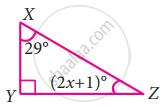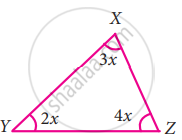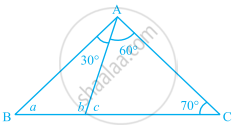Advertisements
Advertisements
प्रश्न
Two adjacent angles are equal. Is it necessary that each of these angles will be a right angle? Justify your answer.
उत्तर
We know,
Two angles are said to be adjacent, if they have a common vertex, a common arm, and their non-common arms are situated on different sides of the common arm.
Also, we know that the linear pair axiom states that, if a ray stands on a line, then the sum of the two adjacent angles so formed is 180°.
It is given to us that the two adjacent angles are equal. Let us assume each of the adjacent angles measures x.
We know that the sum of two adjacent angles is 180°.
⇒ x + x = 180°
⇒ 2x = 180°
⇒ x = 90°
Thus, each of the adjacent angle is 90°.
APPEARS IN
संबंधित प्रश्न
In the following triangle, find the value of x
In the following triangle, find the value of x
In ∆RST, ∠S is 10° greater than ∠R and ∠T is 5° less than ∠S, find the three angles of the triangle
In ∆ABC, if ∠B is 3 times ∠A and ∠C is 2 times ∠A, then find the angle
In a right angled triangle MNO, ∠N = 90°, MO is extended to P. If ∠NOP = 128°, find the other two angles of ∆MNO
How many triangles can be drawn having its angles as 53°, 64° and 63°? Give reason for your answer.
Prove that through a given point, we can draw only one perpendicular to a given line.
[Hint: Use proof by contradiction].
In the given figure, find the values of a, b and c.

Each of the two equal angles of an isosceles triangle is four times the third angle. Find the angles of the triangle.
If one angle of a triangle is 60° and the other two angles are in the ratio 1:2, find the angles.
